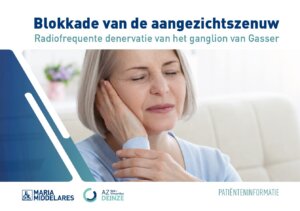Blockage of the facial nerve
What is it?
What is it?Our body has twelve cerebral nerves. In contrast to all the other nerves in our body, the cerebral nerves originate directly from the brain. These nerves are responsible for our senses for example. Some nerves facilitate feeling (sensory) and others facilitate movement (motor).
One of the cerebral nerves is responsible for feeling in the face. This is the fifth cerebral nerve, namely the trigeminal nerve. This nerve splits into three separate branches. The point where the nerves branches out is the nerve ganglia, the trigeminal ganglion. This ganglia is located at the cranial base, at the level of the ear.
Trigeminal neuralgia is a very painful condition in which pain (usually shooting pain) is in one or more branches of the facial nerve. The shooting pains feel like short electrical shocks, like being stabbed with a sharp knife or burning stabs. They can be brought on by touching, shaving or washing one's face. Chewing, swallowing, heat or cold may also cause the pain. The skin may also be overly sensitive, leading to severe pain with just a light touch.
There can be several causes for the pain symptoms (blood vessel that presses again the nerve source, MS, etcetera). Sometimes, no specific cause is found.
Medication is the preferred treatment for facial pain. If medication does not prove effective, a radiofrequency treatment of the trigeminal ganglion can be performed. Blocking this ganglion reduces the pain.
Process
ProcessPreparation
Come to the hospital on the day of treatment. The physician will tell you beforehand whether you need to be fasting for the procedure.
| Medication | Stop | Comments |
|---|---|---|
| Asaflow®, Aspégic®, Cardioaspirin®, Aspirin® Dispirl®, Sedergin® | Stop if >500 mg/day | |
| Marcoumar®, Sintrom® Marevan® | Seven days before the procedure | Replace with injections (see Clexane, for example) Anticoagulation before the procedure |
| Ticlid® | ten days before the procedure | |
| Plavix®, Clopidogrel Brilique®, Efient® | Seven days before the procedure | |
| Xarelto®, Eliquis® Lixiana®, Pradaxa® | 48 hours before the procedure | |
| Fraxiparin®, Clexane® Fraxodi® | 24 hours before the procedure | Start taking these again a minimum of six hours after the treatment • Three days afterwards take together with regular blood thinners • Have a anticoagulation follow-up with your GP one week after |
Always inform the physician if:
- you have diabetes or a heart condition
- you are (or could be) pregnant
- you are allergic to certain medication, contrast medium or iodine (disinfectant), latex, etcetera
- you take blood thinners
If you have reduced kidney function, have recently experienced thrombosis or a heart attack or have had a stent implanted, you must contact your attending physician first.
Test
The test consists of two parts.
- The nurse places an IV in your arm once you are in the operating room. Antibiotics are administered to reduce the risk of infection. Afterwards, you will lie down on your back on the operating table.
- The anaesthesiologist will administer a mild anaesthesia medication intravenously. Your heart rhythm, blood pressure and blood oxygen will be continuously monitored during the treatment.
- Your skin will be disinfected, which can feel cold. The precise injection site will be determined using an X-ray machine. The skin around the site will be numbed with a local anaesthetic. You will fall asleep for a short period. The needle is introduced to the desired area.
- Once the needle is at the right location, the anaesthesiologist will wake you in order to perform a test to confirm that the position is correct. The goal is to feel a 'zing' in the region where you normally feel pain.
- If your physician is satisfied with the needle's position, the anaesthesiologist will put you back to sleep. Using a radiofrequency current, heat of 60°C is induced three times, for sixty seconds each time. This disconnects the pain conduction.
- When the treatment is complete, you will be woken up.
- After the treatment, you will be brought to the recovery room where we monitor your blood pressure, heart rate and pain. If necessary, you will receive extra pain medication. If you feel good, you may go back to your room. You will remain for one night in the hospital. The follow-up physician will visit you the following morning. If everything is fine, you may go home. You will have a follow-up appointment on discharge to discuss the result of the treatment. Medication that you were taking prior to treatment can usually be reduced following a taper and then stopped.
Leaflet
LeafletSee the leaflet below for more information about:
- blockage of the facial nerve
- the possible side effects and complications
Only available in Dutch:

Brochure blokkade van de aangezichtszenuw
DownloadCentres and specialist areas
Centres and specialist areas
Something wrong or unclear on this page? Report it.
Latest publication date: 13/08/2024
Supervising author: Dr. Decaigny Veronique





